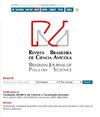Relationship of Linoleic and Alpha-Linolenic Acids on the Productive Performance and Serum Biochemical Profile of Japanese Quail Breeders
IF 1.1
4区 农林科学
Q3 AGRICULTURE, DAIRY & ANIMAL SCIENCE
引用次数: 0
Abstract
Linoleic (LA, 18:2) and alpha-linolenic (ALA, 18:3) acids are omega-6 and omega-3 polyunsaturated fatty acids considered essential to human and animal health. The optimum LA/ALA ratio for the production of fertile eggs in Japanese quail breeders has been little investigated. Thus, this study aimed to assess the effects of LA/ALA ratio on productive performance, egg quality, serum biochemical profile, body composition, and organ weight in Japanese quail. A completely randomized design was used. Birds were distributed into five treatments consisting of different LA/ALA ratios (1.48:1, 4.57:1, 7.63:1, 10.69:1, and 13.75:1), obtained by adding soybean (LA) and flaxseed (ALA) oils to the feed. Productive performance and egg quality were assessed in three cycles of 28 days each. At the end of the experiment, the birds were slaughtered and evaluated for biochemical profile, genital organ weights, and body composition. Data were subjected to analysis of variance and regression ( p <0.05). LA/ALA ratio had no effect on productive performance or egg quality. Blood cholesterol in females and males and total triglycerides in females showed a quadratic response. Breeders fed the highest level of flaxseed oil (1.48:1) had the best serum levels of cholesterol and total triglycerides. Live weight and relative organ weights were not influenced by LA/ALA ratio. Differences in ash and crude protein levels were observed between groups, with LA increasing the deposition of these nutrients. It was concluded that LA/ALA ratio didn’t affect productive performance or egg quality. However, based on the results of body composition, serum triglycerides, and cholesterol, it is recommended to use an LA/ALA ratio of 1.48:1 in diets.亚油酸和α -亚麻酸对日本鹌鹑生产性能和血清生化指标的影响
本文章由计算机程序翻译,如有差异,请以英文原文为准。
求助全文
约1分钟内获得全文
求助全文
来源期刊

Brazilian Journal of Poultry Science
农林科学-奶制品与动物科学
CiteScore
1.80
自引率
9.10%
发文量
60
审稿时长
>12 weeks
期刊介绍:
A Revista Brasileira de Ciência Avícola surgiu em 1999 a partir da necessidade que a comunidade científica possuía de um periódico para veiculação e publicação de seus trabalhos, com a publicação de três números anuais.
A Revista conta hoje com um corpo editorial altamente qualificado e com artigos científicos desenvolvidos pelos maiores especialistas da área, o que a cada dia atrai mais leitores em busca de inovação e respaldo técnico.
Devido à credibilidade que conquistou pelos esforços de sus autores, relatores e revisores, a Revista ganhou caráter de coleção, sendo consultada como fonte segura de estudo desenvolvidos na Avicultura.
A partir de 2003 – volume 5 -, a Revista passou a chamar-se Brazilian Journal of Poultry Science, e todos os trabalhos passaram a ser publicados em inglês. No mesmo ano subiu para quatro o número de revistas por volume, ampliando-se assim os trabalhos publicados anualmente.
 求助内容:
求助内容: 应助结果提醒方式:
应助结果提醒方式:


